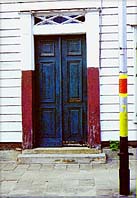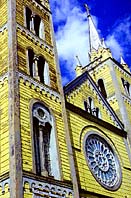Paramaribo
The capital city of Suriname is Paramaribo. 180,000 people
lived in Paramaribo in 1998. The total population for Suriname
was estimated in 1996 to be about 405,000 people. Thus almost
one out of every two Surinamers lives in the capital city.
 The
English where the first people to try and conquer the land. But
it was the Dutch who would leave their stamp on Suriname. Dutch
settlers arrived on the South American coastline in 1616. In
1667 Suriname became a Dutch colony. But the colony never thrived.
The Dutch were more enamored with their East Indian colonies,
which were far more profitable. Slaves were imported from West
Africa and were treated with extreme cruelty. Many of these slaves
escaped into the jungle where they continued to live a West African-style
life. The five principal Maroon tribes in Suriname are the descendants
of these runaway slaves. The
English where the first people to try and conquer the land. But
it was the Dutch who would leave their stamp on Suriname. Dutch
settlers arrived on the South American coastline in 1616. In
1667 Suriname became a Dutch colony. But the colony never thrived.
The Dutch were more enamored with their East Indian colonies,
which were far more profitable. Slaves were imported from West
Africa and were treated with extreme cruelty. Many of these slaves
escaped into the jungle where they continued to live a West African-style
life. The five principal Maroon tribes in Suriname are the descendants
of these runaway slaves.
 Still,
the Dutch influence on Suriname can be easily seen in Paramaribo.
European-style wood-framed buildings which are several hundred
years old can be seen in the downtown area. One of the city's
landmarks is the largest wooden cathedral in South America. The
cathedral was built by the Roman Catholic Church in 1835. Still,
the Dutch influence on Suriname can be easily seen in Paramaribo.
European-style wood-framed buildings which are several hundred
years old can be seen in the downtown area. One of the city's
landmarks is the largest wooden cathedral in South America. The
cathedral was built by the Roman Catholic Church in 1835.
Suriname's population is one of the most ethnically diverse
in the world. Peoples from Java, India, Africa, China, and Holland
live together peacefully. Each ethnic group preserves its own
culture. Relationships (marital, political, etc.) tend to follow
ethnic lines. But people from each group can be seen working,
playing, and mingling together in the schools, shops, and streets
in downtown Paramaribo.
|



